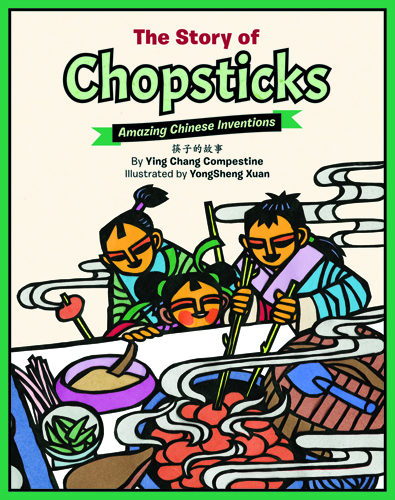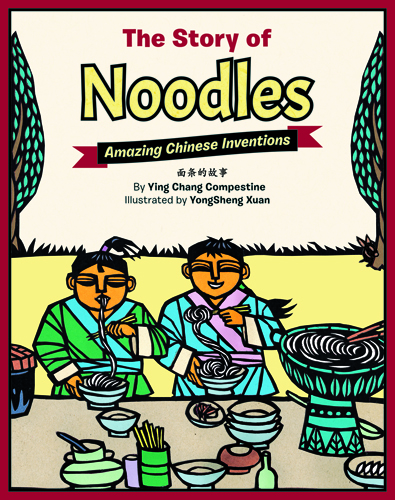| ________________
CM . . .
. Volume XXII Number 30. . . .April 8, 2016
excerpt:
Written by Ying Chang Compestine and illustrated by YongSheng Xuan, the two picture books The Story of Chopsticks and The Story of Noodles are part of the series “Amazing Chinese Inventions” and are designed to educate readers about specific Chinese inventions. Originally published by Holiday House from 2001 to 2003, these republished books are bilingual as they include the original English text and a translation into simplified Chinese text. Both books focus on the Kang family and are told from the viewpoint of Kùai, one of their sons. Although the Kang family’s experiences are fictitious, these stories provide an attractive means for teaching readers about Chinese inventions in a non-didactic manner. Instead, readers will find the stories themselves to be interesting and, along the way, they will learn a bit more about China. Both books present a similar narrative trajectory as they both open with a situation in the Kang family that prompts Kùai to act, with positive yet unexpected results. The Story of Chopsticks begins by mentioning that Chinese people have eaten with their hands historically and that Kùai Kang is frustrated because he cannot get enough food to eat. Since the food is too hot, he is unable to pick it up sooner, but, if he waits too long, his brothers may eat it all. As a result, he invents “chopsticks” so that he can pick up the food sooner. His invention is initially seen as something novel and dubious, but their popularity soon spreads and is adopted by the rest of their village and other communities in China. The Story of Noodles follows a similar narrative trajectory and starts with the Kang siblings commenting that they wish they could eat something else other than rice, thereby foreshadowing later events in the story. When the Kang siblings’ mother asks them to help her shape the dough into dumplings for a cooking contest, Kang has a bright idea to quicken the process. However, when things go wrong and the dough is ruined, they improvise and invent something called mian tiao, which means “flour strips”. As it turns out, their noodle invention’s originality causes them to win the cooking contest. Xuan’s colourful illustrations with their thick, bold outlines are eye-catching and complement the text in both books by highlighting the specific situations that are currently occurring. In some instances, they contribute to the story’s humour, such as when Xuan illustrates a scene in The Story of Noodles in which the three brothers make a mess with the dough and end up breaking the kitchen table. Similarly, in The Story of Chopsticks, Xuan depicts the scene when the Kang brothers take out their chopsticks at the wedding banquet and immediately grab the food to eat, an action which prompts a chaotic situation when the other kids rush to get “chopsticks” so that they can also start eating sooner. One concern of literary critics is to consider the ways in which Asian cultures get represented in literature, particularly in terms of whether they are portrayed realistically or whether they are represented as exotic entities or foreigners. This concern has been important because Asians have historically been marginalized or underrepresented in Canadian literature. Given when these two books were originally published, they provide an important intervention into the existing literature by foregrounding Chinese characters as the main protagonists rather than as supporting or marginal characters in their narratives. Although these books take place in historical China, they do resist stereotypical representations by, for example, depicting Kùai and his brothers as ordinary kids who can misbehave like anyone else. Similarly, the books’ representations of Chinese cultural practices, such as their food and customs, would not be particularly foreign to readers. Even for readers who may have limited knowledge of China, these books demystify these cultural references and make them more accessible to readers in various ways. For example, The Story of Chopsticks has step-by-step instructions on how to use chopsticks. Neither book has a glossary for unfamiliar vocabulary, but readers will not find any cultural references or other terminology to be challenging as the author includes explanations for these within the text itself. For instance, when the Kang family brings gifts to a wedding banquet in The Story of Chopsticks, the author explains that red silk and oranges are symbols of celebration and wealth. Each story also includes an “Author’s Note” that gives more information about the origins and history of chopsticks and noodles, along with a recipe related to the story itself. The story about chopsticks has a recipe for rice pudding whereas the other book has a noodle recipe; these recipes make the food more accessible to readers. In relation to their inclusion of Chinese cultural references, it is important to note that these two books are not meant to be historically accurate narratives about how chopsticks and noodles were invented, but rather to offer engaging and, at times, humorous stories about these inventions from a young person’s perspective. Furthermore, these books exemplify how stories can be educational without being didactic, which does not necessarily diminish their value as children’s literature. Indeed, long-standing debates about the role and value of children’s literature continue today. Although storytelling for children has historically been for both entertainment and education, the evolution in children’s literature illustrates the wide range of authorial intentions that may lie behind the writing of specific works and how these can be shaped by cultural, social, and political contexts of an author’s time. As a result, the extent to which a book’s educational element may be overt or intentional can vary significantly. At first glance, The Story of Chopsticks and The Story of Noodles are each identifiably educational, given their titles and cover illustrations. However, it is soon clear that these are stories rather than nonfiction narratives. Nevertheless, Compestine’s two books may encourage readers to learn more about the inventions covered. Given these books’ target audience, each story is fairly straightforward and easy to comprehend, both in terms of the narrative and the difficulty of language used. The bilingual text will also make both books good resources for children in immersion programs or even for children in English or Mandarin classes, since teachers can use these stories to facilitate learning in either language. In terms of their subject matter, elementary school teachers could use these books to stimulate discussion about Chinese culture and history within the context of a social studies unit on China or an English unit on Asian-themed literature for young readers. In a scholarly context, the books could be considered in terms of their representations of Chinese culture and history as well as childhood. As stated on its website, Immedium is based in San Francisco and publishes books on a wide range of subjects, from children’s fiction to contemporary nonfiction. Despite the younger target audience for these picture books, adults or older children could also appreciate them. To learn more about the author and illustrator, readers can visit Ying Chang Compestine’s website at http://www.yingc.com/ and YongSheng Xuan’s site at http://www.ysxuan.com/. Recommended. Huai-Yang Lim has a degree in Library and Information Studies. He enjoys reading, reviewing, and writing children’s literature in his spare time.
To comment on this title or this review, send mail to cm@umanitoba.ca.
Copyright © the Manitoba Library Association. Reproduction for personal use is permitted only if this copyright notice is maintained. Any
other reproduction is prohibited without permission.
CM Home |
Next Review |
Table of Contents for This Issue - April 8, 2016
| Back Issues | Search | CM Archive
| Profiles Archive |

